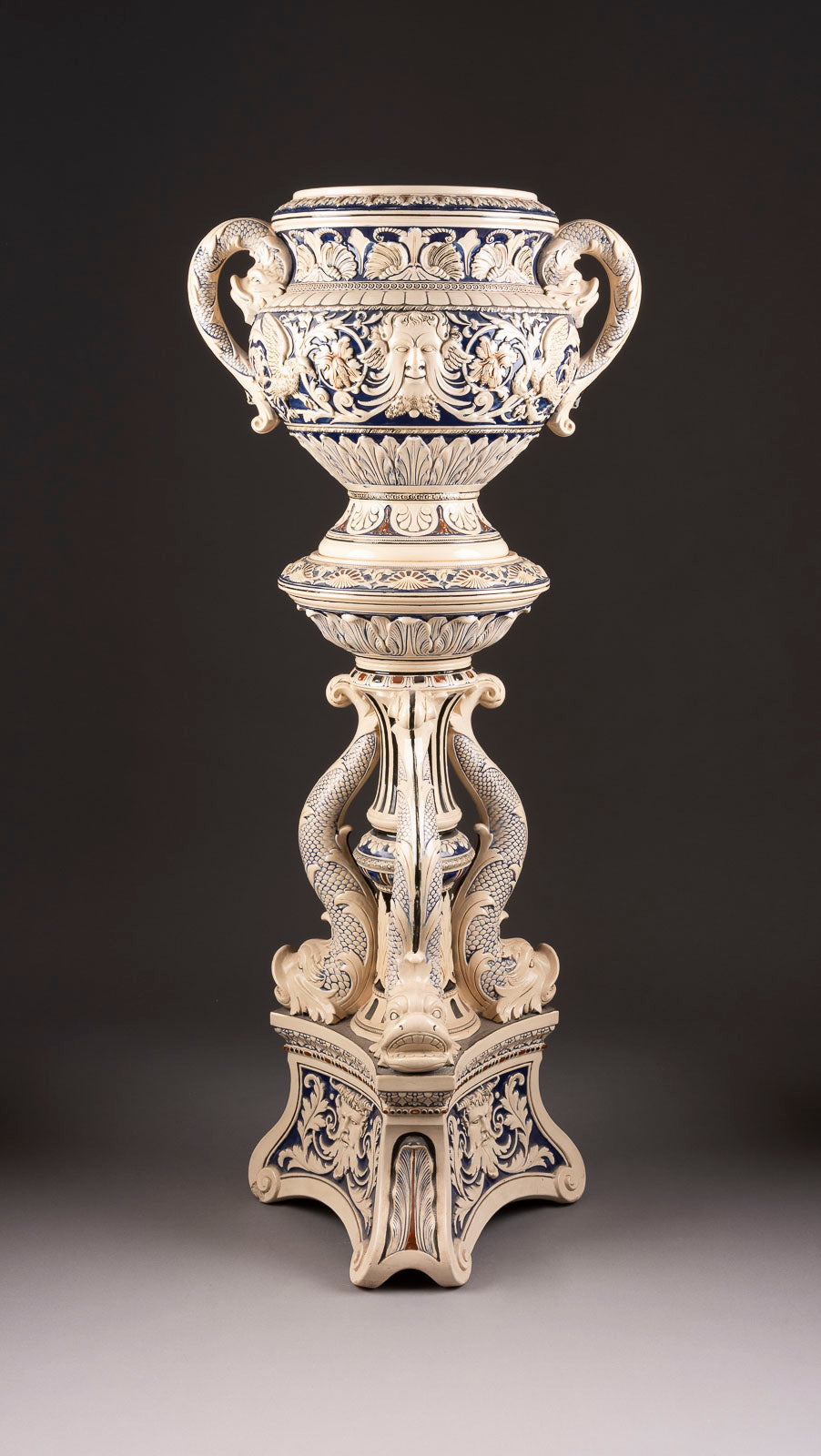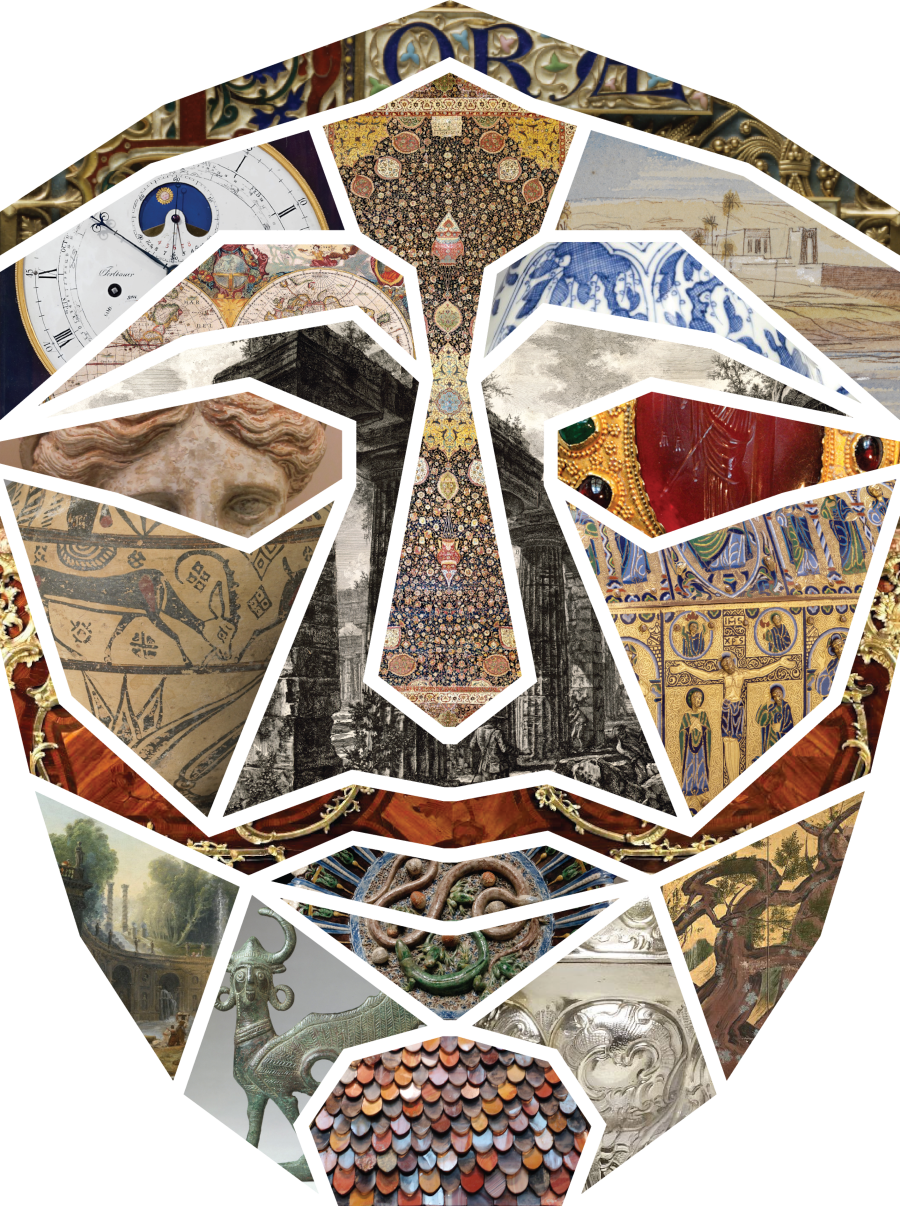My Store
Höhr Marzi Remy Ceramic Planter Column 122cm c.1890 - German Historism Cachepot
Höhr Marzi Remy Ceramic Planter Column 122cm c.1890 - German Historism Cachepot
Couldn't load pickup availability
A Truly Stunning and Rare Decorative Planter on Column by Höhr, Marzi & Remy c.1890
An extraordinary and museum-quality late 19th-century ceramic planter on column by the distinguished German ceramics firm Höhr, Marzi & Remy. Standing an impressive 122 cm tall, this monumental blue and white piece exemplifies the Historism style's elaborate decoration and classical references. The planter features pressed model numbers '497' for the column and '498' for the cachepot, documenting its authentic Marzi & Remy manufacture. The pedestal's three facets and volute feet with three dolphins around the shaft, combined with rich relief decoration of mascarons, griffins, grotesques, vegetal motifs, and ornaments, create a spectacular example of German ceramic artistry at its finest.
Höhr, Marzi & Remy - Distinguished German Ceramics
Marzi & Remy (later Marzi & Remy GmbH) stands as one of the most important German ceramics manufacturers of the 19th and early 20th centuries. Based in Höhr-Grenzhausen in the Westerwald region of Germany, an area renowned for centuries of ceramic production, the firm specialized in high-quality decorative ceramics including jardinieres, planters, vases, and architectural ceramics. Their work combined traditional German ceramic techniques with contemporary Historism and Art Nouveau aesthetics. Marzi & Remy pieces are distinguished by their quality of manufacture, elaborate decoration, and the firm's characteristic pressed model numbers. Works by this firm are highly sought after by collectors of German ceramics and 19th-century decorative arts.
Circa 1890 Dating - Historism Period
The circa 1890 dating places this planter during the height of the Historism period (roughly 1850-1900), when European decorative arts drew inspiration from historical styles including Renaissance, Baroque, and classical antiquity. Historism ceramics are characterized by elaborate decoration, classical motifs, monumental scale, and technical virtuosity. This period saw tremendous innovation in ceramic manufacturing while maintaining high standards of craftsmanship and artistic quality. Ceramics from this era represent the culmination of centuries of European ceramic tradition combined with 19th-century industrial capabilities.
Monumental Scale - 122cm Height
Standing 122 cm (approximately 4 feet) tall, this planter commands impressive presence and demonstrates ambitious scale characteristic of Historism decorative arts. Monumental ceramics required exceptional technical skill to manufacture - managing large-scale molds, controlling drying and firing of substantial pieces, and achieving consistent quality throughout. The impressive height makes this planter suitable as architectural element and focal point in grand interiors, conservatories, entrance halls, or gardens. Scale dramatically enhances both visual impact and market value.
Blue and White Decoration - Classic Palette
The blue and white color scheme references centuries of ceramic tradition, from Chinese porcelain to Dutch Delftware to German faience. This classic palette's enduring appeal lies in its visual clarity, elegance, and versatility. The blue decoration against white ground creates strong visual contrast that enhances the relief decoration's sculptural qualities while maintaining refined aesthetic appropriate for various settings. The color combination's timeless character ensures the planter's continued relevance across changing decorative tastes.
Pressed Model Numbers - Authentication
The pressed model numbers '497' (column) and '498' (cachepot) provide definitive authentication of Marzi & Remy manufacture. These impressed marks, applied during production, document the firm's systematic approach to production and allow precise identification of specific models. The presence of clear model numbers dramatically enhances authenticity, provenance, and collector value. Documented Marzi & Remy pieces command significant premiums over unmarked examples.
Elaborate Relief Decoration - Artistic Excellence
The planter's rich relief decoration demonstrates exceptional artistic and technical achievement. The decorative program includes: mascarons (decorative faces or masks) - classical motifs appearing throughout European decorative arts; griffins - mythological creatures combining eagle and lion, symbolizing strength and vigilance; grotesques - fantastical ornamental designs inspired by ancient Roman decoration; vegetal motifs - naturalistic plant forms adding organic beauty; and ornamental details creating overall visual richness. This elaborate decoration required skilled mold-making, careful casting, and meticulous finishing, demonstrating Marzi & Remy's commitment to artistic excellence.
Three-Faceted Pedestal with Volute Feet
The column's three-faceted design with volute (scroll-shaped) feet demonstrates sophisticated understanding of classical architectural principles. The triangular plan creates visual interest while providing stable base. Volute feet, derived from classical architecture's Ionic capitals, add elegance and historical reference. This architectural sophistication elevates the planter from mere functional object to sculptural artwork embodying centuries of design tradition.
Dolphin Decoration - Classical Symbolism
The three dolphins around the shaft reference classical mythology and decorative tradition. Dolphins, associated with the sea god Poseidon/Neptune, symbolize intelligence, protection, and good fortune. Their appearance in decorative arts connects to Renaissance and Baroque traditions of incorporating classical mythology into ornamental programs. The dolphins' sculptural modeling adds three-dimensional interest while demonstrating the mold-makers' skill in capturing naturalistic detail.
Cachepot Function - Practical Beauty
A cachepot (French for 'hide pot') is a decorative container designed to conceal a plain plant pot, combining practical function with aesthetic beauty. This design allows plants to be grown in practical containers while displayed in beautiful cachepots. The substantial size accommodates large plants or arrangements, making it suitable for palms, ferns, or dramatic floral displays. The combination of beauty and function exemplifies 19th-century decorative arts' integration of aesthetics and utility.
Condition - Honest Assessment
The cachepot shows some hairline cracks, which is expected and acceptable for ceramics of this age and scale. Hairline cracks, common in large antique ceramics due to thermal stress during firing or age-related material changes, typically don't affect structural integrity or significantly diminish value when appropriately disclosed. The cracks add character and authenticity, documenting the piece's age and history. Detailed condition assessment available to serious collectors. The overall preservation allowing this monumental piece to survive 130+ years intact represents remarkable achievement.
Investment Value and Collectibility
Monumental Marzi & Remy ceramics with documented model numbers, elaborate decoration, and impressive scale represent solid investment opportunities. The combination of distinguished maker, circa 1890 dating, 122cm height, elaborate Historism decoration, and authenticated model numbers creates strong appeal among collectors of German ceramics, 19th-century decorative arts, and monumental ceramics. As authentic period pieces by documented makers become scarcer, quality examples show consistent market appreciation.
Display and Presentation
This planter's monumental scale and elaborate decoration make it suitable as focal point in grand interiors, conservatories, entrance halls, formal gardens, or architectural settings. The impressive height creates dramatic vertical emphasis while the blue and white palette works beautifully in both traditional and contemporary contexts. The planter can be used functionally with plants or displayed empty as pure sculpture. Professional installation recommended given the piece's weight (40kg) and value.
Cultural and Historical Significance
This planter embodies late 19th-century German ceramic excellence, the Historism period's elaborate aesthetic, and the Westerwald region's centuries-long ceramic traditions. It represents the intersection of industrial capability and artistic craftsmanship that characterized the best 19th-century decorative arts. The piece connects to broader European traditions of monumental decorative ceramics and the period's passion for historically-inspired design.
Collecting Context
This planter appeals to collectors of German ceramics, Marzi & Remy works, Historism decorative arts, monumental ceramics, and those seeking impressive architectural elements. It would enhance grand private residences, corporate collections, institutional holdings, or serve as centerpiece in collections focused on 19th-century European decorative arts. The combination of scale, quality, and provenance makes it suitable for the most distinguished collections.
Available for viewing by appointment at Artemisia Fine Arts & Antiques Ltd, Malta. We provide expert consultation, condition assessment, insurance valuation, and international shipping coordination with specialized ceramic handlers. Price excludes shipping cost given the piece's substantial size and weight. This represents an exceptional acquisition opportunity for collectors of monumental German ceramics. Serious inquiries from qualified collectors welcome.
Share




